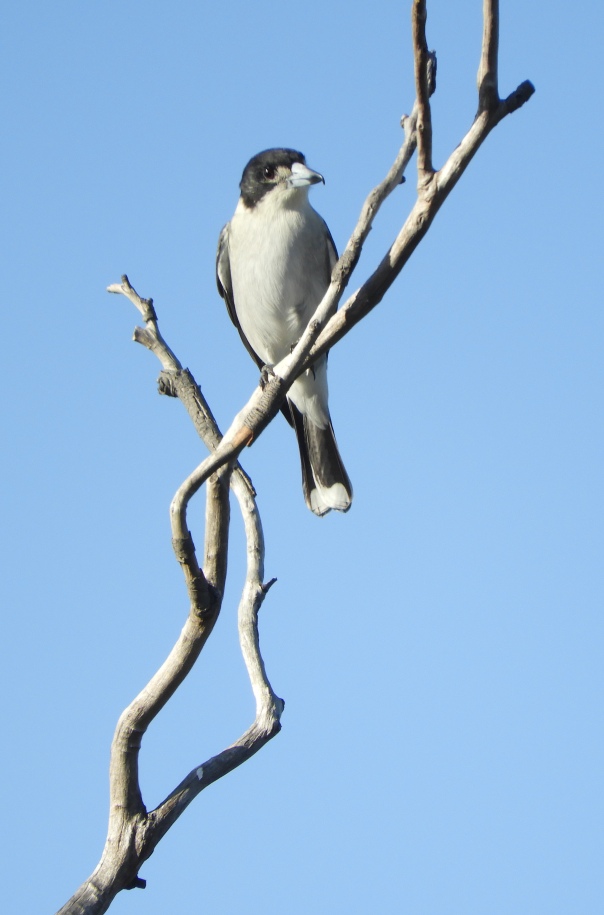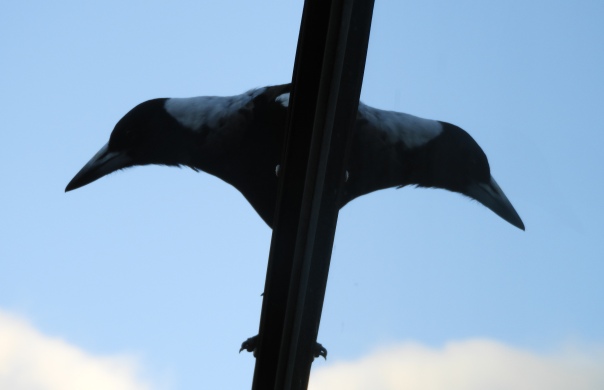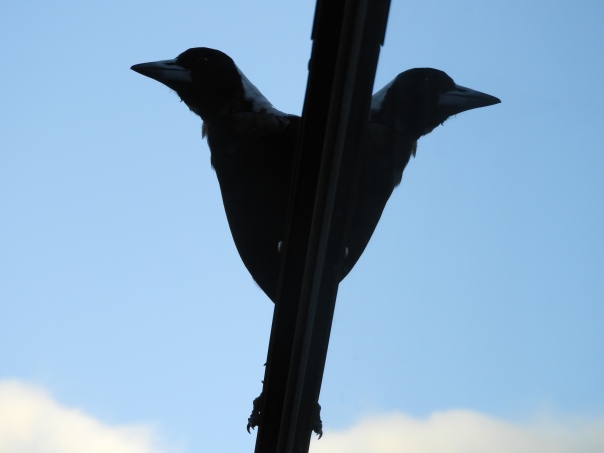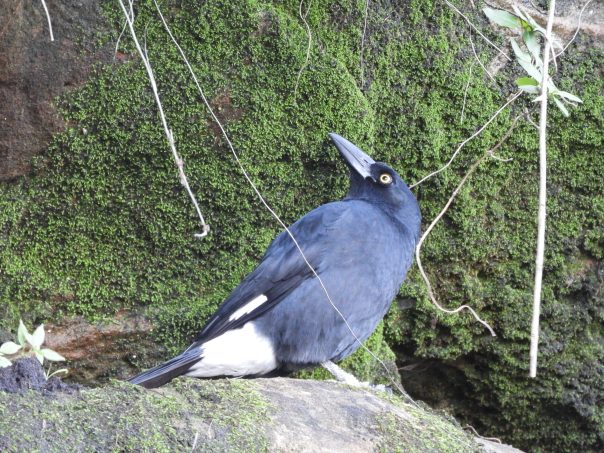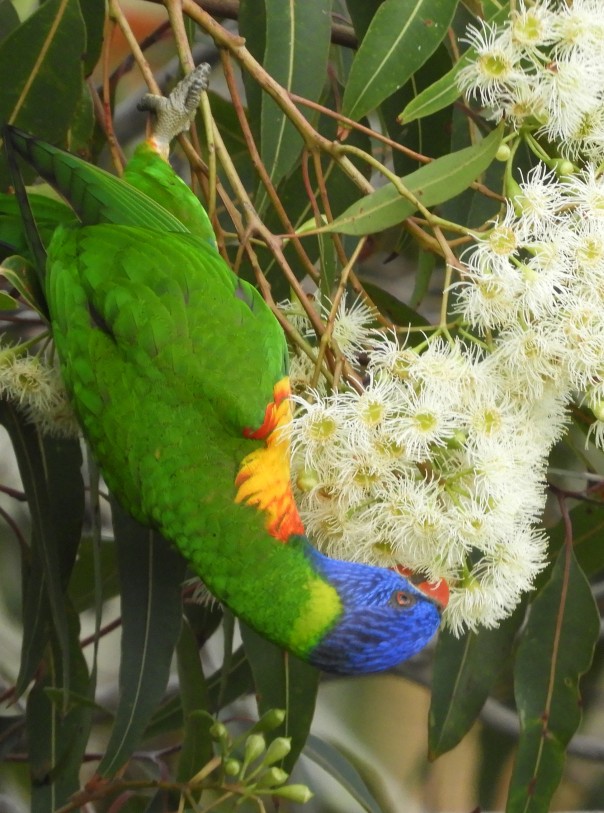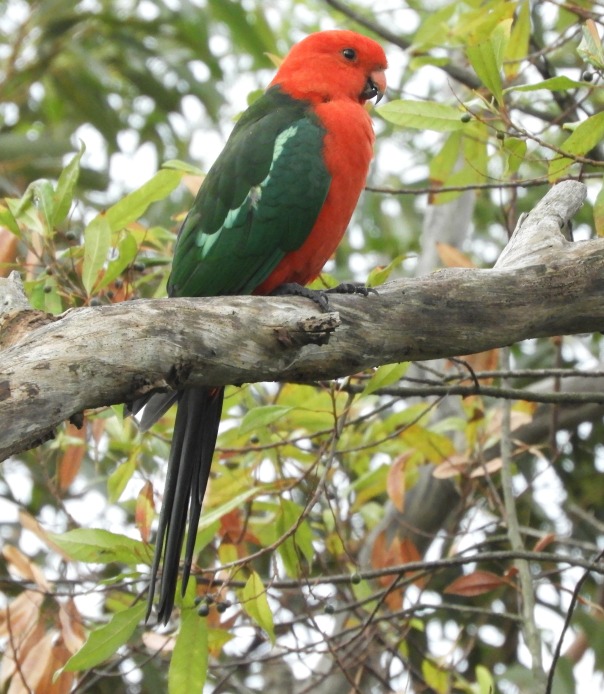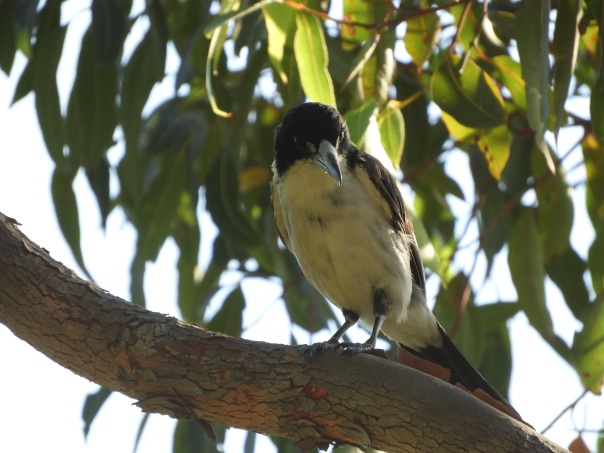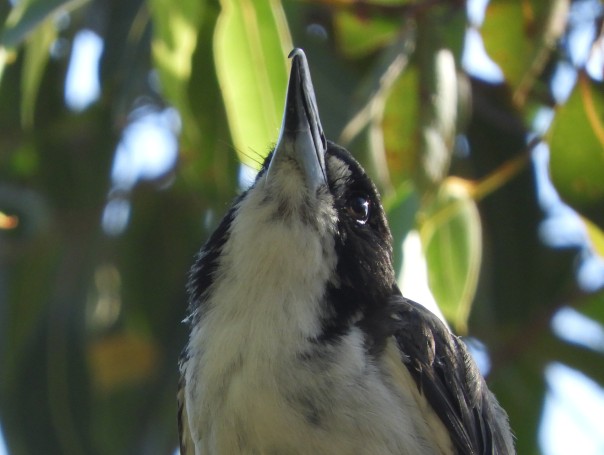Category Archives: Butcherbird
Alas, butcherbirds nest abandoned when tree fern sprouted
In my previous post, I wrote about a pair of Grey Butcherbirds that had built their nest in a tree fern below our house. The problem with tree ferns is that they sprout new fronds from the centre of the trunk, exactly where the birds had built their nest.
The photos of the nest in my earlier post were taken on the 18th of September. Just a few days later, the tree fern did indeed sprout a new frond, putting the nest at an uncomfortable angle. Still, the butcherbirds persevered. This photo, taken on the 25th of September shows one of the birds sitting determinedly on a very slanted nest, which presumably still contained the three eggs:
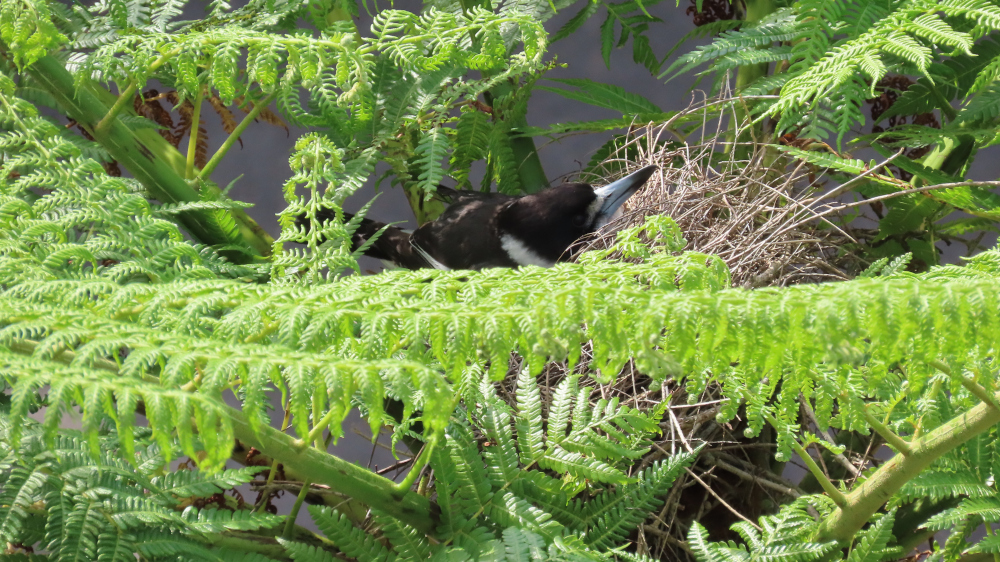
Just a day later, the birds had abandoned the nest. I don’t know if the eggs were still in the nest. The tree fern is way too high for me to go up and take a look:

By yesterday, the 5th of October, the new fern frond had pushed the nest to the top of the canopy:

Never mind little butcherbirds, there’s still plenty of time left this season to try again. Or next year perhaps.
Perhaps they’ll have learned something about real estate from this experience. Grey Butcherbirds live for around 20 years, so there’s plenty of time for learning!
Common name: Grey Butcherbird
Scientific name: Cracticus torquatus
Approximate length: 30 cm
Date spotted: 18 September to 5 October 2025 (spring)
Location: Allambie Heights, NSW, Australia
Butcherbird nest in tree fern – hope it survives
A pair of Grey Butcherbirds have built their nest in a tree fern below our house. The problem with tree ferns is that they sprout new fronds from the centre of the trunk, exactly where the nest is now. And these are big fronds! I hope the butcherbirds manage to hatch the eggs and raise their young before the next sprouting happens.
Here’s the nest with a butcherbird sitting on the eggs:

There are at least two eggs, maybe three, in the nest. Here’s a shot taken when the nest was briefly unattended:
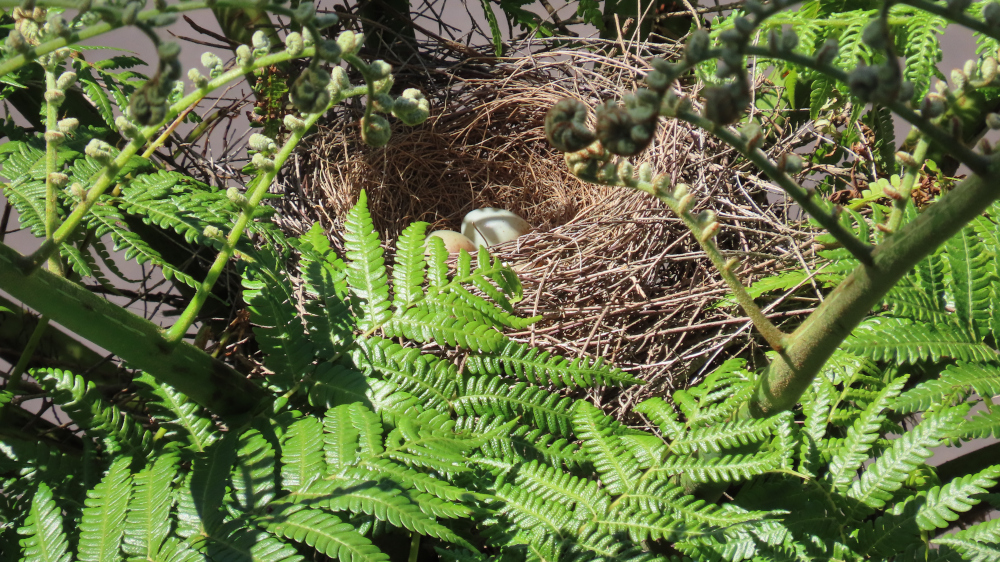
Here’s another shot of the bird on the nest, not as closely zoomed in:

This is the tree fern, as seen from my window without zooming in:

It’s interesting to see that inexperienced avian parents can make mistakes about where to place their nests. A while ago, a Red Wattlebird nest appeared in a similar tree fern in another area of our garden. Alas, that nest was very soon skewed and then skewered by a new frond, and had to be abandoned. However, a family of Noisy Miners was more successful.
Grey Butcherbirds incubate the eggs for about 25 days, and the fledgelings leave the nest after about four weeks. Evidently Grey Butcherbirds live around 20 years. That’s a long time, and gives them plenty of time to learn about the best place to build their homes.
Good luck, little butcherbirds!
Common name: Grey Butcherbird
Scientific name: Cracticus torquatus
Approximate length: 30 cm
Date spotted: 18 September 2025 (spring)
Location: Allambie Heights, NSW, Australia
Pied Butcherbird singing on the beach
As I walked past this tree, on a grassy patch next to the sea at Port Macquarie, I heard a gentle experimental whistling. I thought it might be a person, but then I heard some bird sounds mixed in. It was a Pied Butcherbird, trying out its repertoire while perched in an Old Man Banksia tree. In the background is the sound of the surf, rather noisy alas.
We don’t see these birds around Sydney, so I’m not familiar with their calls. I wonder if this one is different from most, or perhaps they sing a variety of songs?
Common name: Pied Butcherbird
Scientific name: Cracticus nigrogularis
Approximate length: 33-36 cm
Date spotted: 5 June 2025 (winter)
Location: Town Beach, Port Macquarie, NSW, Australia: 31°25’47.6″S 152°55’09.5″E
Pied Butcherbirds, adult and juvenile
This is just my second sighting of a Pied Butcherbird, and this time I was lucky to see both an adult and a young bird. This was at the Mann River Nature Reserve near Glen Innes, NSW, just off the Old Grafton Road.
Note: Thank you to Sue, who corrected my original thought that the juvenile was a female. As Sue points out in her comment below, the male and female adult birds are very similar in appearance.
Here’s the adult bird:

In the next photo, the view from behind shows the wide white collar that goes all the way round the bird’s neck. I think it’s the same bird as in the previous photo, but I don’t know for sure:

Here’s the young bird, in the same tree:

Common name: Pied Butcherbird
Scientific name: Cracticus nigrogularis
Approximate length: 33-36 cm
Date spotted: 5 July 2024 (winter)
Location: Mann River Nature Reserve in NSW, just off the Old Grafton Road: 29°41’18.3″S 152°05’56.6″E
Mann River makes a pretty picture, meandering around grey-white rocks and surrounded by natural forest:
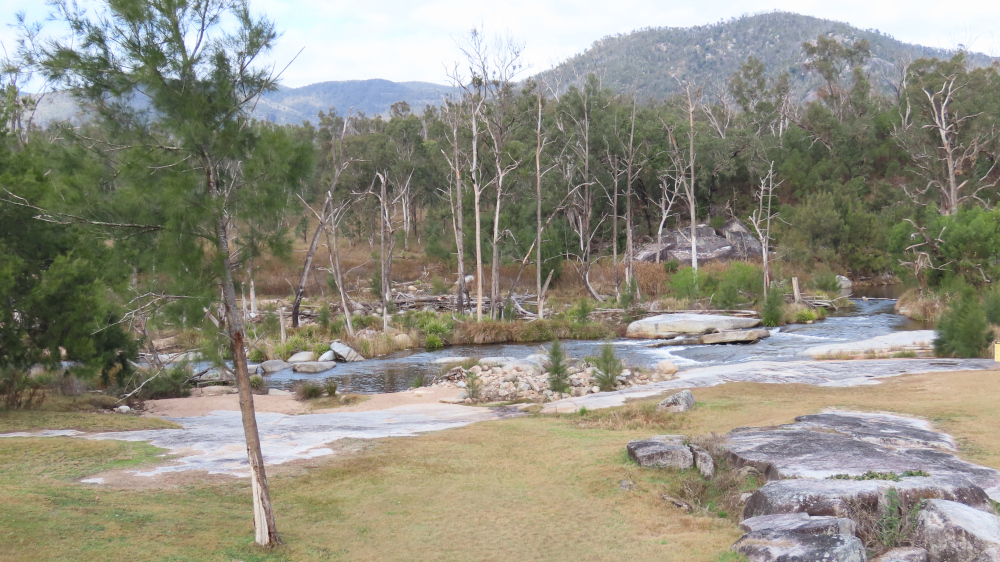
Butcherbirds sang to me!
Early one morning, at the place I was staying at near Brisbane, two Grey Butcherbirds dropped down and sang to me.
It felt very special to have these birds come so close and sing their song. I suspect they were hoping I’d produce a snack. This is the first time I’ve had this experience, though a few magpies have sung to me in the past.
Here’s a still picture of one of the birds:
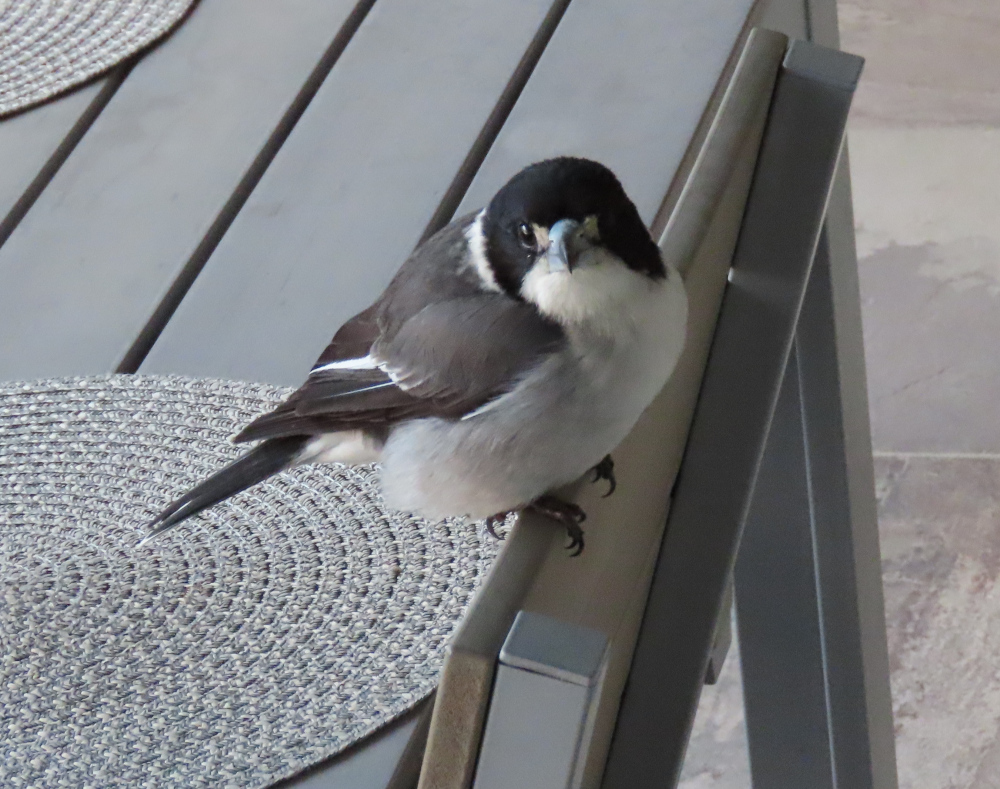
Butcherbirds are medium-sized songbirds, widely spread in Australia. They’re only distantly related to the South African shrikes that are also known as butcherbirds. Both groups of birds get their name from their habit of securing their captured prey on spikes or in crevices, to store the prey for youngsters or to make it easier to eat.
Common name: Grey Butcherbird
Scientific name: Cracticus torquatus
Approximate length: 30 cm
Date spotted: 6 July 2024 (winter)
Location: The Gap, Brisbane, Queensland, Australia: 27°26’55.3″S 152°55’50.2″E
Pied Butcherbird makes 3 out of 4
There are four types of Butcherbird in Australia: Grey Butcherbirds, Black Butcherbirds, Black-backed Butcherbirds, and Pied Butcherbirds. Grey Butcherbirds are common on Australia’s east coast, where I live. I’ve seen a Black Butcherbird when travelling in the far north of Australia. And now, travelling west of Sydney into the Outback, I spotted a Pied Butcherbird. Three out of four ain’t bad!

The white collar of this bird extends in a straight line, all the way round the back of the neck, whereas the Grey Butcherbird’s collar is narrower and doesn’t go all the way round.
Common name: Pied Butcherbird
Scientific name: Cracticus nigrogularis
Approximate length: 33-36 cm
Date spotted: 21 May 2024 (autumn)
Location: Mungo Lodge, Mungo National Park, New South Wales, Australia: 33°44’31.4″S 143°00’06.1″E
Black Butcherbird in Far North Queensland
A few days ago, I was visiting Port Douglas in Far North Queensland. Many of the birds up there have quite different calls from those further south. This Black Butcherbird is an example:
As you can see, the lighting was difficult. I did manage to get a couple of clearer still shots of the bird:
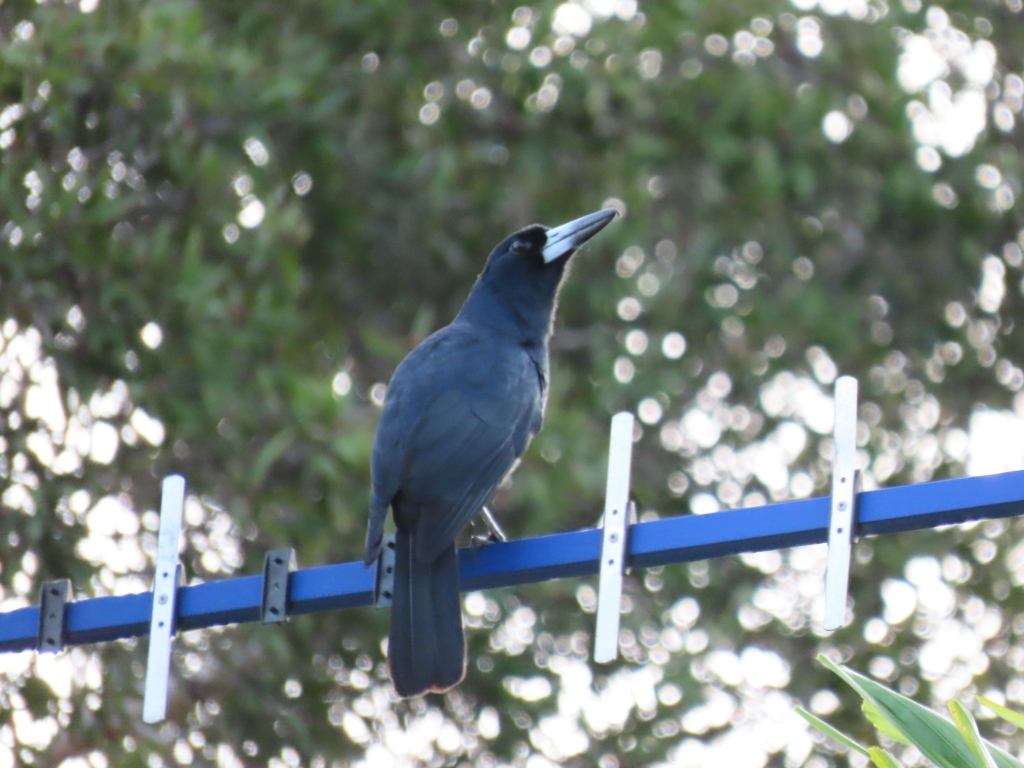
Black Butcherbirds are, as the name implies, entirely black. In Australia, they’re found only in the far north of the continent. Down near Sydney, where I’m based, I’ve only ever seen the Grey Butcherbird, which has a lot of white and grey as well as black plumage. According to my bird book, some Black Butcherbirds (the rulescens race) can be brownish as juveniles.
This is my first sighting of a Black Butcherbird! Here’s another picture of the same bird in full song:

Common name: Black Butcherbird
Scientific name: Cracticus quoyi
Approximate length: 38-44 cm
Date spotted: 17 May 2022 (autumn)
Location: Port Douglas, Far North Queensland, Australia: 16°30’42.2″S 145°27’44.2″E
Grey Butcherbird on blue sky
A Grey Butcherbird posed on a dead tree branch against an autumn-clear sky:
Butcherbirds are one of the types of black-and-white birds that frequent our area. They’re smaller than magpies and currawongs. When you manage to get a close-up view of a butcherbird’s beak, you notice the hook on the end. Magpies and currawongs have straight beaks without a hook:
Butcherbirds eat lizards, mice, small birds, insects, and other small creatures. The next photo shows the bird spotting some small creature in the scrub below. After I captured this shot, the bird swooped down then returned to its perch without its prey.
Common name: Grey Butcherbird
Scientific name: Cracticus torquatus
Approximate length: 30 cm
Date spotted: 8 May 2020 (autumn)
Location: Manly Dam National Park, New South Wales, Australia: 33°46’33.1″S 151°14’47.9″E
Butcherbird has whiskers!
A few butcherbirds are frequenting my area at the moment. This one is a Grey Butcherbird:
When it tilted its head, I noticed some dark whiskers below its eye:
When it looked upwards, I could make out the whiskers on both sides of its beak:
A full-frontal gaze shows off the white patches (lores) in front of its eyes:
A yawn shows its tongue off nicely:
Here’s a profile to close the post. The hook on the end of the beak is for stabbing prey, which the butcherbird then hangs on a branch or a fence until it’s ready to eat:
Common name: Grey Butcherbird
Scientific name: Cracticus torquatus
Approximate length: 30 cm
Date spotted: 5 January 2019 (Summer)
Location: Allambie Heights, New South Wales, Australia






